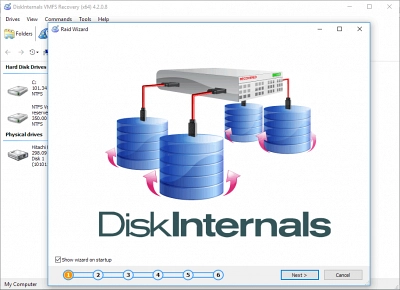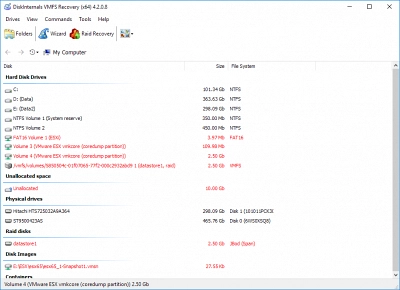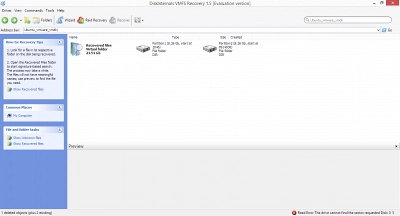How to Extract Content from VMDK Files
There are situations where you’d need to extract the data contained in a VMDK file. VMDK is a file format for virtual hard disks (VHDs). Virtual hard disks are a mimicked (virtual) version of physical hard disks; they contain every information and data needed to launch and run VMware and VirtualBox virtual machines (VMs).
So, practically, what is contained in VMDK files are important files and data of the connected virtual machine. This implies that when a VMDK file gets corrupted, the connected VM won’t launch. This article explains the different possible ways to extract VMDK files and access the data stored inside for specific reasons.
How to Extract Content from VMDK Files on Windows
When your VM refuses to start due to an encrypted or corrupted VMDK file, you will need to open the VMDK file and extract its content – to save it as a new VMDK file and regain access to your VM. VMDK file encryption or corruption can result from malware or virus attacks on the computer system.
Also, cache clusters, incomplete installation files, OS updates, bug fix failures, and other reasons can make a VMDK file inaccessible by the VM. But it’s nothing to worry about; using a professional tool or another ESXi VM, you can extract a VDMK file’s content and gain access to the data you seek.
How Data is Stored in VMDK Files
VMDK, which is the acronym for Virtual Machine Disk File, is a container format by VMware used to represent virtual hard disks (VHD) of virtual machines created using VMware or VirtualBox solutions. VMware’s VM’s virtual hard drives are saved in VMFS partitions (on a physical hard drive) with a .vmdk extension.
Basically, VMDK is a disk image format – just like ISO. However, there are two types of the VMDK file format; VMs hosted on VMware ESXi/ESX servers have their files saved in dual VMDK formats – the virtual disk descriptor file (diskname.vmdk) and the “disk extent” file saved as diskname-flat.vmdk, all these are stored in the ESXi datastore.
In contrast, if you use VMware Workstation, virtual disks are represented by one single diskname.vmdk file (the descriptor and extent data are embedded into this “monolithic sparse” diskname.vmdk file).
On ESXi servers, the descriptor file is just a TXT file that contains the VHD details, such as the IDs, hardware version, and disk geometry, while the “disk extent” –flat file stores the actual Virtual Machine data.
Since the descriptor VMDK file is saved as a mere text document (TXT), you can easily open it using a HEX text editor. But for other VMDK file formats, you can’t open as TXT; you should follow any of these guided methods below to extract the data and launch your VMs.
Sure Ways to Extract Content from VMDK Files
There are a couple of ways to extract VMDK files and have access to the data stored inside. However, this article focuses on the best reliable ways to get this done. Each of these methods should be followed keenly.
1. Use another ESXi Virtual Machine
You can open a corrupt VMDK file using another VM hosted on a different EZXi sever. For this method, you need a virtual machine hosted on the same OS with the previous one that had the corrupted VMDK file.
Caution: Clone the VMDK file you want to extract from – so you can have a copy to fall back on if things go south.
Steps:
- Launch the new (working) ESXi host
- Go to Hosts and Clusters and right-click on the accessible Virtual Machine you’d be using for this test
- Select Edit Settings
- On the Virtual Hardware tab, click on Add hard disk, then Existing hard disk
- Import the VMDK file
- Confirm the file settings and click Save to complete the process
- After that, go to Computer Management 🡺 Disk Management 🡺 select the added VMDK file, right-click and choose the Online option to activate it
- You can now access the VMDK file’s content from Windows Explorer, where you can also extract it if you wish.
2. Use DiskInternals VMFS Recovery
DiskInternals VMFS Recovery is a professional software program that allows you to read and access data stored on VMFS-formatted partitions; so the software can read VMDK files. VMFS Recovery is basically a data recovery tool for recovering virtual machine files; however, it integrates many other handy utility functions, including rebuilding RAID drives.
DiskInternals VMFS Recovery can repair corrupt VMware boot images, ESX Server datastores, non-mounting VMFS volumes, unrecognized VMDK files, and unreadable ESXi volume headers. It is a comprehensive software tool for virtual machine users – especially if your VM is hosted on Windows OS.
Using the DiskInternals VMFS Recovery, you can recover the previous (good) version of your corrupt VMDK file and extract the content to another storage drive.
How to Open VMDK Files with DiskInternals VMFS Recovery on Windows
To open VMDK files on Windows, you can use the “Reader Mode” on DiskInternals VMFS Recovery. Below are the steps to open VMDK files using DiskInternals’ professional VMFS Recovery tool.

- First Step: Download and install the software on your Windows PC, then launch it, and proceed with the next step. This software works on Windows Vista, 7, 8, 10, 11, or Windows Server 2003-2019.

- Second Step: Select the drive with the VMFS partition and choose a recovery mode. You can try “Reader Mode” to open the VMFS partition and access the VMDK file.

- Third Step: If the VMDK file is missing, you can recover it by choosing Full Recovery mode and wait for the scan to complete, and you’d be able to view the VMDK files again.

How to Open VMDK Files with DiskInternals VMFS Recovery on Linux
You can also open the VMDK files even if they are saved on a Linux drive, e.g., EXT-formatted drives. However, you will have to connect the Linux drives to a Windows OS computer to proceed. DiskInternals VMFS Recovery can open all kinds of file systems, including macOS and Linux OS file systems. Below are the steps:
- First Step: Connect or mount the Linux drive on the system running Windows OS. Proceed with downloading and installing DiskInternals VMFS Recovery on the Windows OS system. Then launch it, and proceed with the next step. This software works on Windows Vista, 7, 8, 10, 11, or Windows Server 2003-2019.
- Second Step: Select the Linux drive with the VMFS partition and choose a recovery mode. Select “Reader Mode” to open the VMFS partition and access the VMDK file.
- Third Step: If the VMDK file is missing, you can recover it by choosing Full Recovery mode and wait for the scan to complete, and you’d be able to view the VMDK files again.
3. Using VMware Workstation (Mounting VMDK Files on a Host OS with VMware Workstation)
If you’ve got a VMware Workstation, you can mount the VMDK files on another host.
Note: With VMware Workstation, you can only directly mount or add the VMDK file to a new host as a new volume. Also, the VMDK descriptor and flat file must be in the same folder.
Steps:
- Launch Workstation and select Map Virtual Disks from the File option on the menu bar
- Toggle to the Map tab and import the VMDK file
- Select the Maximum volume size for the file, and unselect Open file in read-only mode
- Map the drive and check the “Open drive in Windows Explorer after mapping” checkbox
- Click OK and then YES to finish up
- You can now open the mapped drive and extract the VMDK files data by copying it to any other storage directory. Disconnect the Virtual Disk afterward
4. Other Methods to Open VMDK Files in Linux
Sure, there are still other ways to open and extract VMDK files. You can use the 7-Zip archive software app to extract the files or use the /dev/loop on a Linux OS system. Also, you can use the VMware Virtual Disk Development Kit (VDDK), which comes with multiple built-in utility tools that allow you to perform different actions.
Conclusion
Conclusively, this article explains the different possible ways to extract files from VMDK. There are different reasons you may want to carry out this operation, and the methods explained above are the safest. DiskInternals VMFS Recovery is a reliable third-party software tool for retrieving lost and deleted VMDK files.
FAQ
How do I extract files from a VMDK file?
1. Use another ESXi Virtual Machine
2. Use DiskInternals VMFS Recovery
3. Use VMware Workstation (Mounting VMDK Files on a Host OS with VMware Workstation)
How do I recover files from VMDK?
DiskInternals VMFS Recovery can repair corrupt VMware boot images, ESX Server datastores, non-mounting VMFS volumes, unrecognized VMDK files, and unreadable ESXi volume headers. It is a comprehensive software tool for virtual machine users – especially if your VM is hosted on Windows OS.
How to extract VMDK in Linux?
You can also open the VMDK files even if they are saved on a Linux drive, e.g., EXT-formatted drives. However, you will have to connect the Linux drives to a Windows OS computer to proceed. DiskInternals VMFS Recovery can open all kinds of file systems, including macOS and Linux OS file systems. Below are the steps:
- First Step: Connect or mount the Linux drive on the system running Windows OS. Proceed with downloading and installing DiskInternals VMFS Recovery on the Windows OS system. Then launch it, and proceed with the next step. This software works on Windows Vista, 7, 8, 10, 11, or Windows Server 2003-2019.
- Second Step: Select the Linux drive with the VMFS partition and choose a recovery mode. Select “Reader Mode” to open the VMFS partition and access the VMDK file.
- Third Step: If the VMDK file is missing, you can recover it by choosing Full Recovery mode and wait for the scan to complete, and you’d be able to view the VMDK files again.
